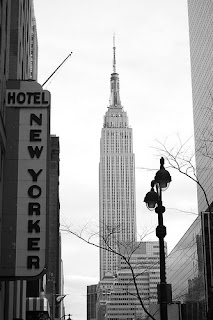 Doug Gatlin
Doug GatlinVice President, LEED
U.S. Green Building Council
It’s a great time to be an existing building.
First: President Obama released last year’s Better Buildings Initiative, focusing financing opportunities on commercial retrofits.
Then: USGBC reported that LEED for Existing Buildings project square footage surpassed new construction projects.
Now: A new report has concluded that building reuse almost always offers environmental savings over demolition and new construction.
 |
| Empire State Building, LEED Gold. Photo credit: John Donges, Flickr |
It’s a hat trick for existing buildings, the many millions of them across the world. There are 838,337 alone in New York City, some three million skyscrapers across the U.S., and 71 billion total square feet covering the country. Everyone from building industry pros to the President of the United States is recognizing the vast potential to curb emissions and ramp up energy efficiency by greening this enormous stock of structures, to the tune of one million jobs. The market share of retrofit projects that are green is expected to rise to one third in 2015: An $18 billion opportunity. USGBC has been stressing the insurmountable benefits of focusing our greening efforts on the existing building stock, and we are thrilled that momentum is growing.
The study, conducted by the Preservation Green Lab of the National Trust for Historic Preservation, underscores one main point: We can, and we should, work with what we’ve got. If we can retrofit and revamp an existing structure as opposed to building new, we absolutely should. Historic buildings almost always fall under this category. The Empire State Building, the Treasury Building in DC, and Chicago’s Wrigley Building are all LEED for Existing Buildings projects. Beyond historic preservation, project teams all over the world are finding new uses for old and even dilapidated buildings. And for those of you who doubt just how flexible an existing building can be: Read how the former Pabst brewery in Milwaukee is being adapted to residential lofts and offices. Or check out this eco-campus in California, formerly a crumbling utility site.
Undoubtedly, we can’t always retrofit. New construction will continue. And in those scenarios, we need to push for new construction projects that are as sustainable and efficient as possible. This is why programs like LEED for New Construction have a central and much-needed place in the buildings realm. According to the report from the National Trust for Historic Preservation, it can take between 10 and 80 years for a new energy efficient building to overcome, through efficient operations, the climate change impacts created by its construction. Can you imagine how long it would take a traditional building to offset its impact?
LEED for New Construction is working to get that turnaround time to zero years. Credits in the rating system focus on minimizing construction-related emissions by sourcing materials locally and diverting waste sustainably. Looking forward to LEED 2012, we’ve added pilot credits that focus on life cycle assessment of building assemblies and materials. If we’re going to build new, we need to build smart. We need to build green.
Greening our existing buildings makes the best use of the structures we already have. Maximizing sustainability in our new construction projects is an equal priority.
At USGBC, we applaud – and encourage – both. LEED will continue to evolve to raise the bar in both of these markets.

Leave a Reply
You must be logged in to post a comment.